4 Steps to Safe Cost Cutting by Mary Patry

It is no secret that many industries and market’s bottom line profits are being walloped by the COVID-19 impacts. The impact is real. You have been asked to cut a substantial portion of the IT budget and fast. Your challenge is to deliver the reductions needed while maintaining services. Join me in exploring an approach to tackling the challenge as safely as possible.
Let us begin.
1. Start with a solid understanding of the current state of IT Spend: How much and in what places
Let me share an analogy…You need surgery! Can you imagine allowing a surgeon to start cutting without diagnostic tests identifying the root of your health issue? As scary as that concept might be, you must perform the same diagnostics before you start a cost-cutting initiative.
How do you know where to cut unless you know the costs and drivers?
I am not talking about the need for a Total Cost of Ownership analysis. I am advocating that you understand your spending from a high level. It is most useful to sort spend into three different views:
IT Spend by Strategic Category
Most IT costs sit in the Run category of spend (average of 65-70% percent of the total budget). Run costs are typically committed contract costs. Unfortunately, we see these costs rising each year unless there has been a continuous program to control run costs. The Grow category focuses on enhancing business processes with new IT-based capabilities, whereas Transform is in support of new business activities.
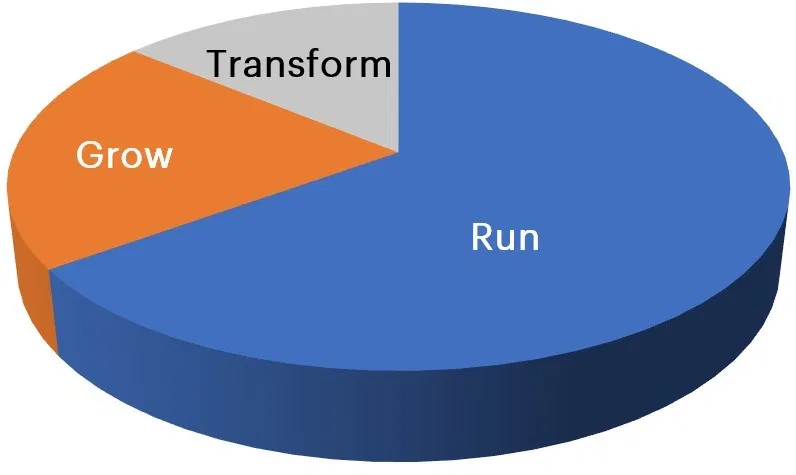
The first opportunity here is in the creation of a center of excellence comprised of IT, Finance, and Key business operational representatives tasked with ensuring the continuous improvement in the efficiency of IT services. The need for business representation is strategic. It is also an excellent opportunity to solicit their input into the reduction of Run service delivery expectations.
More important, it is an excellent time to educate the business on the operational impact of IT investment decisions. Without this education and attention, trailing maintenance costs increase the run costs of the business by 15-20% year over year as illustrated in the chart below.
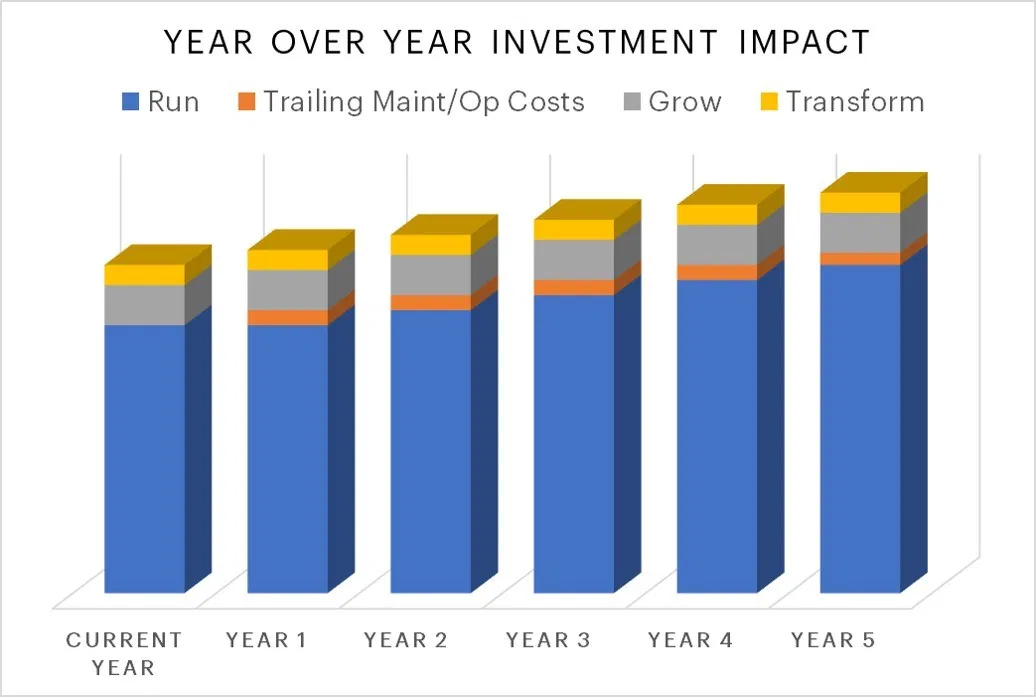
IT Spend by Cost Component
These days, the most substantial portion of IT costs for most organizations is associated with internal staff and outsourcing. Improving cost-effectiveness and enabling cost reductions will require a detailed look at services by category and identification of duplication of services while exploring alternative delivery models.
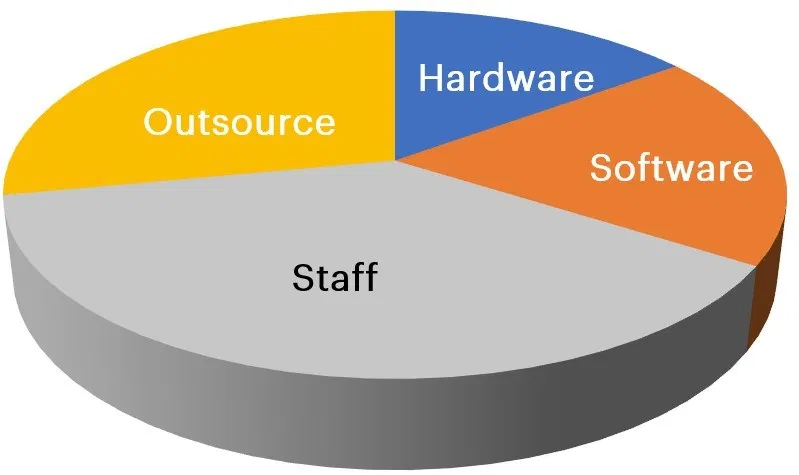
These days, the most substantial portion of IT costs for most organizations is associated with internal staff and outsourcing. Improving cost-effectiveness and enabling cost reductions will require a detailed look at services by category and identification of duplication of services while exploring alternative delivery models.
The opportunity here is to look deep into each cost component to understand the opportunities to renegotiate, extend, or eliminate contracts or services. This is also the time to take a deep look, often for the first time, at the organizational design and staff skills inventory in preparation of a likely call to reduce staff or headcount.
Do you know who your essential team members are?
IT Spend by Technology Domain
IT spending is spread across a combination of infrastructure, application, service desk, and IT management workload areas.
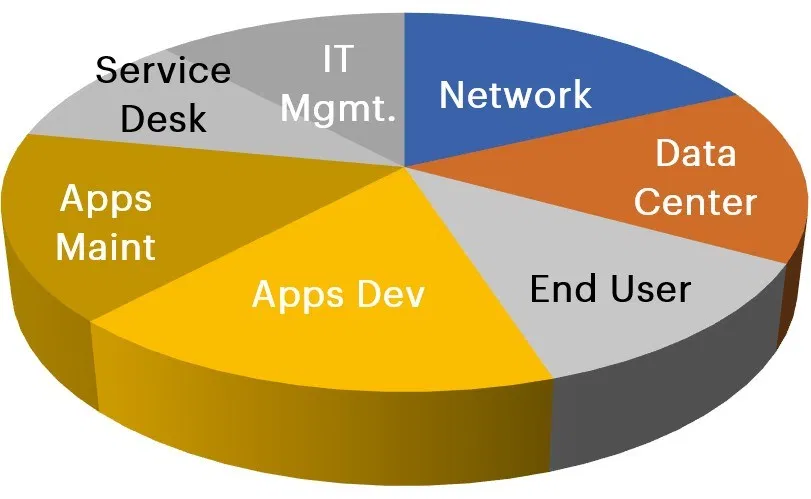
Experience shows us that there are real opportunities for significant cost savings and service improvements in each of these areas. Areas of cost reduction opportunities might include renegotiating service contracts, extending service life, consolidating data centers, or reducing the number of applications.
2. Next, look for opportunities to cut costs.
- Quick cost-saving “WINS”: Scrutinize in-flight or planned Grow or Transform initiatives to eliminate or defer anything that does not contribute to immediate cost reductions or profit margin increase.
- One-time hard savings (current spending or next budget cycle}: Reduce fixed costs by a set amount in the present or future budget cycle/quarter.
- Recurring hard savings (current spending or next budget cycle): Reduce variable costs regularly, proportionate to volume, in the present, or next budget cycle/quarter.
- Reduced future costs: Savings on what would have been spent during out years. For example, renegotiating a three to five-year maintenance contract reduces savings in out years, which should be captured and tracked, but don’t have the same cash-flow impact as savings in the current or next budget cycle.
- Expense deferral: Taking an action that will result in an expense being due and payable at a future date, rather than during the current time period. Many cost optimization efforts make the mistake of not differentiating between putting off a cost into the future and making structural changes that will reduce the long-term run rate.
- Staff/Headcount reductions: Reduction in force is never easy and often results in significant lost productivity. Analyze your skills inventory against critical functions and talk in detail. Without this level of scrutiny, staff reductions represent the highest risk of cutting to the bone. It is essential to have a clear understanding of the functions of every team member.
As you list your opportunities for cost cutting, keep in mind that not all cost cutting efforts are helpful. There is a downside to attempting the wrong kind of cuts. Some can be quite dangerous to the intended outcome as well as IT’s reputation. Here are a few to consider:
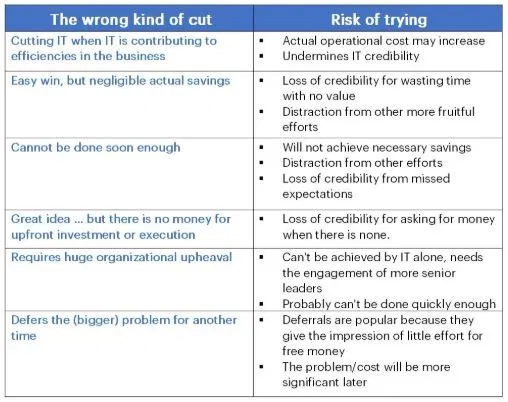
3. Finally, inform and negotiate cost-cutting targets
Most often, IT cost reduction goals are dictated by the CEO or CFO with directives such as “Cut your total cost by X%.” This is understood. At the same time, the CIO will demonstrate managerial courage in clearly articulating and informing the business of both the positive and negative impact of that directive. When opportunities and risks are articulated in clear business terms, the CIO can earn the right to negotiate the goal in partnership with the business leadership.
4. Last, execute against the plan
Seriously, this is hard stuff. By putting the extra effort in the analysis, you will be better positioned to manage costs and be prepared for the next time. There is always a next time.
Click here to read article on ITEffectivity.com
Mary Patry
IT Executive Advisor and Leadership Coach
☎ 480.393.0722 (AZ)
✉ Mary.Patry@iteffectivity.com
LinkedIn: http:// www.linkedin.com/in/mleonardopatry